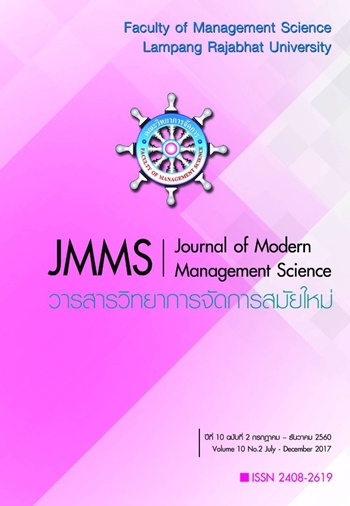Information Transparency, Decision Making Quality and Firm Profitability: Evidence from Thai Listed Firms
Main Article Content
Abstract
This paper aims at examining the effects of information transparency on decision making quality and firm profitability of Thai listed firms through governance mechanism as a moderator. In this paper, 143 listed-firms in Thailand are the samples of the paper. The results indicate that information transparency has a positive effect on decision making quality. Decision making quality has a positive influence on firm profitability. Also, decision making quality is the mediator of the information transparency-firm profitability relationships. Likewise, governance mechanism is the moderator of the information transparency-decision making quality relationships. Then, the executives of organizations should support organizational resources and pay attention and search for guidelines in developing more transparent information. Theoretical and managerial contributions, conclusion and suggestions and directions for future research are highlighted.
Article Details
The article must be considered and accepted for publication by the editorial board of the Faculty of Management Science, Lampang Rajabhat University. The articles have been reviewed by a peer (peer review) and the author must update according to the suggestion if available before publication. Articles that are not considered the editorial team will inform the results of the consideration but will not send the original to the author.
JMMS is the Faculty of Management Science journal, Lampang Rajabhat University. Jmms published both print and online editions. We allow the use of articles for academic use under the scope of copyright law.
References
Al-Jabri, I. M., & Roztocki, N. (2015). Adoption of ERP systems: Does information transparency
matter? Telematics and Informatics, 32, 300-310.
Armstrong, J. S., & Overton, T. S. (1977). Estimating non-response bias in mail surveys, Journal of
Marketing Research, 14(3), 396-402.
Arora, A., & Fosfuri, A. (2000). Wholly owned subsidiary versus technology licensing in the
worldwide chemical industry, Journal of International Business Studies. 31(4): 555-572.
Baron, R. M., & Kenny, D. A. (1986). The moderator-mediator variable distinction in social
psychological research: Conceptual, strategic and statistical considerations, Journal of
Personality and Social Psychology. 51 : 1173-1182.
Bushman, R., Piotroski, J., & Smith, A. (2004). What determines corporate transparency? Emerging
Markets Finance and Trade. 50(4) : 237-253.
Chiang, H., & He, L. (2010). Board supervision capability and information transparency,
Corporate Governance: Am International Review, 18(1): 18-31.
Churchill, G. A., Jr. (1979). A paradigm for developing better measures of marketing constructs,
Journal of Marketing Research, 16 : 64–73.
Hair, J. F., Black, W. C., Babin, B. J., & Anderson, R. E. (2010), Multivariate data Analysis: A
global perspective. 7th Edition. New Jersey: Person Prentice Hall.
Hung, H., & Wong, Y. H. (2009). Information transparency and digital privacy protection: Are they
mutually exclusive in the provision of e-service? Journal of Services Marketing. 23(93):
154-164.
Jarboui, S., Guetat, H., & Boujelbene, Y. (2015). Evaluation of hotels performance and corporate
Governance mechanisms: Empirical evidence from the Tunisian context, Journal of
Hospitality and Tourism Management. 25: 30-37.
Jap, S. D., & Ganesan, S. (2000). Control mechanisms and the relationship life cycle: Implications
for safeguarding specific investments and developing commitment, Journal of Marketing
Research. 37 : 227-245.
Michie, S. G., Dooley, R. S., & Fryxell, G. E.. (2006). Unified diversity in top-level teams:
Enhancing collaboration and quality in strategic decision-making, International
Journal of Organizational Analysis. 14(2): 130-149.
Neter, J., Wasserman, W., & Kutner, M. H. (1985). Applied Linear Statistical Models: Regression,
Analysis of Variance, and Experimental Designs, 2nd Edition. Homewood: Richard D.
Irwin, Inc.
Nunnally, J. C., & Bernstein, I. H. (1994). Psychometric Theory. New York, NY: McGraw-Hill.
Ozimec, A., Natter, M., & Reutterer, T. (2010). Geographical information systems-based marketing
decisions: Effects of alternative visualizations on decision quality, Journal of Marketing,
74, 94-110.
Seo, Y. W., Lee, K. C., & Lee, D. S. (2013). The impact of ubiquitous decision support systems on
decision quality through individual absorptive capacity and perceived usefulness, Online
Information Review. 37(1): 101-113.
Storey, C, & Kocabasoglu-Hillmer, C. (2013). Making partner relationship management systems
work: The role of partnership governance mechanisms, Industrial Marketing
Management. 42: 862-871.
Ussahawanitchakit, P. (2007). The influences of management capability on export
performance of leather businesses in Thailand, Review of Business Research. 7(5): 1-10.
Vaccaro, A., & Madsen, P. (2006). Firm information transparency: Ethical questions in the
information age, International Federation for Information Processing, 223: 145-156.
Wadhwa, S., Mishra, M., Chan, F. T. S., & Ducq, Y. (2010). Effects of information transparency and
Cooperation on supply chain performance: A stimulation study, International Journal of
Production Research. 48(1): 145-166.
Williams, A. (2015). A global index of information transparency and accountability, Journal of
Comparative Economics, 43(3): 804-824.
Yeh, Y. M. C., Chen, H., & Wu, M. (2014). Can information transparency improve earnings quality
attributes? Evidence from an enhanced disclosure regime in Taiwan, Emerging Markets
Finance and Trade, 50(4): 237-253.
Zahra, S. A., Ireland, R. D., & Hitt, M. A. (2000). International expansion by new venture firms:
International diversity, mode of market entry, technological learning, and performance,
Academy of Management Journal, 43(5): 925-950.


